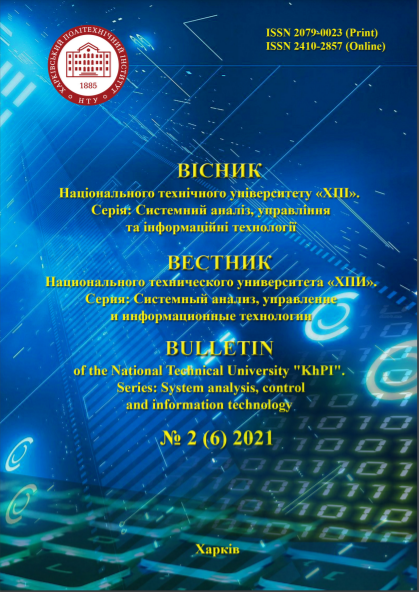COUNTERFACTUAL TEMPORAL MODEL OF CAUSAL RELATIONSHIPS FOR CONSTRUCTING EXPLANATIONS IN INTELLIGENT SYSTEMS
DOI:
https://doi.org/10.20998/2079-0023.2021.02.07Keywords:
explanation, intelligent information system, temporal rules, causality, cause-and-effect relationshipsAbstract
The subject of the research is the processes of constructing explanations based on causal relationships between states or actions of an intellectual
system. An explanation is knowledge about the sequence of causes and effects that determine the process and result of an intelligent information
system. The aim of the work is to develop a counterfactual temporal model of cause-and-effect relationships as part of an explanation of the process of
functioning of an intelligent system in order to ensure the identification of causal dependencies based on the analysis of the logs of the behavior of
such a system. To achieve the stated goals, the following tasks are solved: determination of the temporal properties of the counterfactual description of
cause-and-effect relationships between actions or states of an intelligent information system; development of a temporal model of causal connections,
taking into account both the facts of occurrence of events in the intellectual system, and the possibility of occurrence of events that do not affect the
formation of the current decision. Conclusions. The structuring of the temporal properties of causal links for pairs of events that occur sequentially in
time or have intermediate events is performed. Such relationships are represented by alternative causal relationships using the temporal operators
"Next" and "Future", which allows realizing a counterfactual approach to the representation of causality. A counterfactual temporal model of causal
relationships is proposed, which determines deterministic causal relationships for pairs of consecutive events and pairs of events between which there
are other events, which determines the transitivity property of such dependencies and, accordingly, creates conditions for describing the sequence of
causes and effects as part of the explanation in intelligent system with a given degree of detail The model provides the ability to determine cause-andeffect relationships, between which there are intermediate events that do not affect the final result of the intelligent information system.
References
Engelbrecht Andries P. Computational Intelligence: An Introduction. NJ: John Wiley & Sons, 2007. 632 р.
Gunning D., Aha D. DARPA’s Explainable Artificial Intelligence (XAI) Program. AI Magazine. 2019. no 40(2), pp. 44-58.
Swartout W., Moore J. Explanation in Second Generation Expert Systems. David J-M., Krivine J-P., Simmons R. (ed) Second generation expert systems, Springer-Verlag. 1993, pp. 543-585.
Tintarev N., Masthoff J. A survey of explanations in recommender systems. The 3rd International workshop on web personalisation, recommender systems and intelligent user interfaces (WPRSIUI'07). 2007, pp. 801-810.
Lewis D. Counterfactual Dependence and Time’s Arrow. Counterfactuals and Laws. 1979. Vol. 13, no. 4, pp. 455-476.
Lewis D. Causation. Journal of Philosophy. 1973, no 70 (17), pp. 556-567.
Lewis D. Causation as influence. Journal of Philosophy. 2000., vol. 97, no. 4, pp. 182–97.
Paul L. A. Aspect Causation. In Collins, Hall & Paul. 2004, pp. 205– 24.
Paul L. A., Hall. N. Causation: A User’s Guide. Oxford: Oxford University Press, 2013. 259 p.
Halpern J. Y. Axiomatizing causal reasoning. Journal of Articial Intelligence Research. 2000, no 12, pp. 317-337.
Halpern J. Y., Pearl J. Causes and explanations: A structural-model approach. Part I: Causes. The British Journal for the Philosophy of Science. 2005, no. 56 (4), pp. 843-887.
Halpern J. Y., Pearl J. Causes and explanations: A structural-model approach. Part II: Explanations. The British Journal for the Philosophy of Science. 2005, 56 (4), pp. 889-911.
Miller D. T., Gunasegaram S. Temporal order and the perceived mutability of events: Implications for blame assignment. Journal of personality and social psychology. 1990, no 59 (6), pp. 1111- 1118.
Chalyi S., Leshchynskyi V., Leshchynska I. Informatsiina tekhnolohiia pobudovy poiasnen z urakhuvanniam temporalnykh zmin u vymohakh korystuvachiv rekomendatsiinoi systemy [Information technology of construction of explanations considering temporal changesin requirements of the recommender system's users]. Systemy upravlinnia, navihatsii ta zviazku [Control, navigation and communication systems]. 2020, no 3, pp. 99-103.
Chalyi S., Leshchynskyi V., Leshchynska I. Deklaratyvnotemporalnyi pidkhid do pobudovy poiasnen v intelektualnykh informatsiinykh systemakh [Declarative-temporal approach to the construction of explanations in intelligent information systems]. Visnyk Nats. tekhn. un-tu "KhPI": zb. nauk. pr. Temat. vyp. Systemnyi analiz, upravlinnia ta informatsiini tekhnolohii [Bulletin of the National Technical University "KhPI": a collection of scientific papers. Thematic issue: System analysis, management and information technology]. Kharkov, NTU "KhPI" Publ, 2020, no. 2(4), pp. 51-56.
Chalyi S., Leshchynskyi V. Temporal representation of causality in the construction of explanations in intelligent systems. Advanced Information Systems. 2020, vol. 4, no 3, pp. 113-117.
Chalyi S., Leshchynskyi V., Leshchynska I. Vykorystannia temporalnykh vlastyvostei kauzalnykh zalezhnostei u poiasnenniakh v rekomendatsiinykh systemakh [Use of temporal properties of causal dependences in explanations in recommendation systems]. VI Mizhnarodna naukovo-tekhnichna konferentsiia «Kompiuterne modeliuvannia ta optymizatsiia skladnykh system» [VI International Scientific and Technical Conference "Computer Modeling and Optimization of Complex Systems"]. 2020, pp. 169-170.
Ehring D. Causal Relata. Synthese. 1987, no 73(2), pp. 319–28.
Downloads
Published
How to Cite
Issue
Section
License
LicenseAuthors who publish with this journal agree to the following terms:
- Authors retain copyright and grant the journal right of first publication with the work simultaneously licensed under a Creative Commons Attribution License that allows others to share the work with an acknowledgement of the work's authorship and initial publication in this journal.
- Authors are able to enter into separate, additional contractual arrangements for the non-exclusive distribution of the journal's published version of the work (e.g., post it to an institutional repository or publish it in a book), with an acknowledgement of its initial publication in this journal.
- Authors are permitted and encouraged to post their work online (e.g., in institutional repositories or on their website) prior to and during the submission process, as it can lead to productive exchanges, as well as earlier and greater citation of published work (See The Effect of Open Access).


